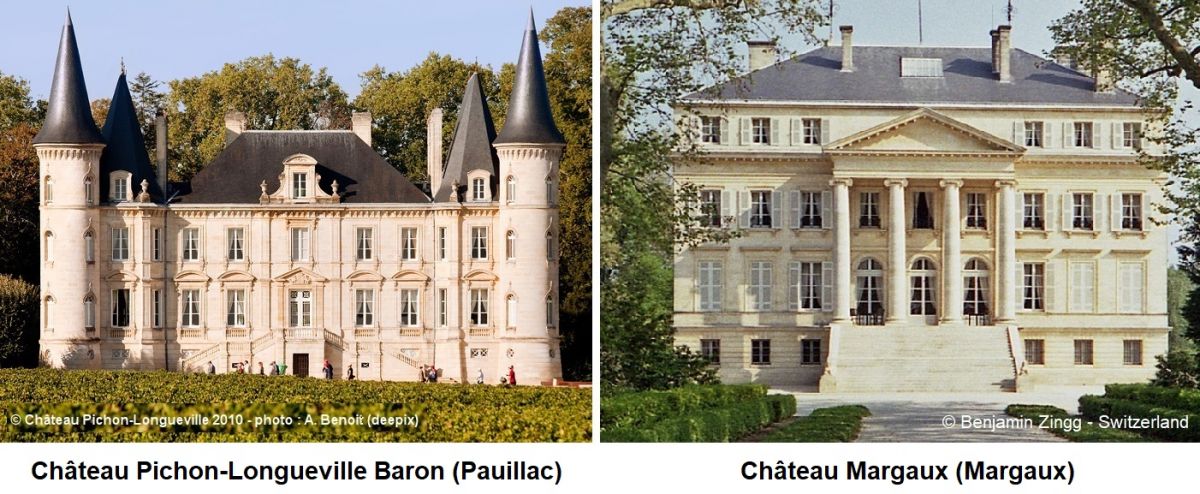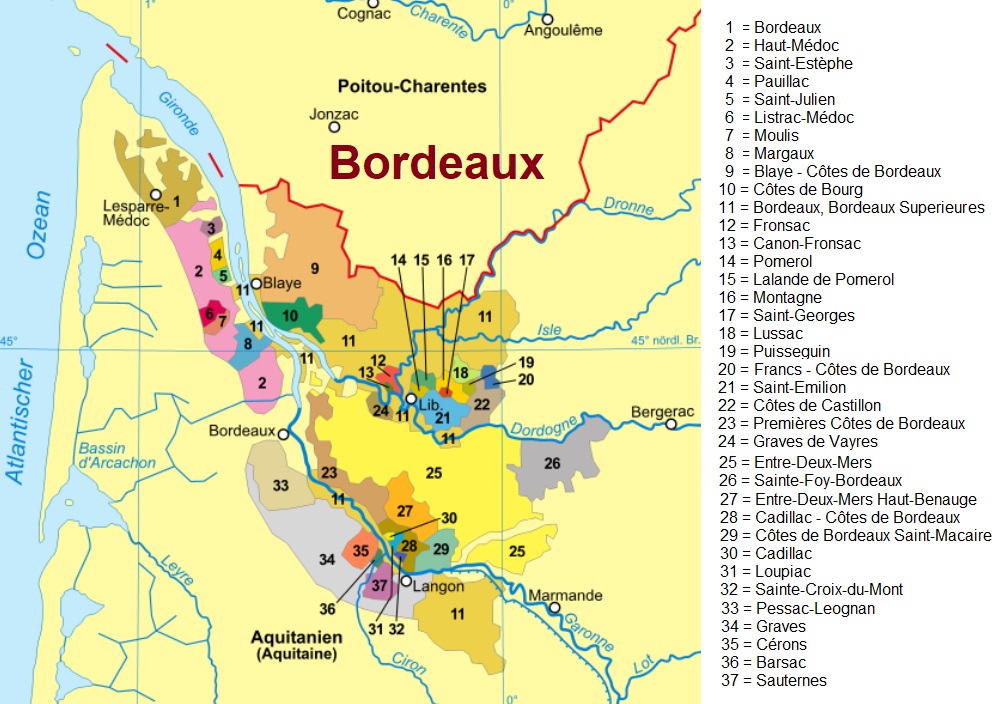Results
2,284 Results
Loading more Results ...
Loading more Results ...
Wine regions in Bordeaux 53 growing regions
Description to Bordeaux
The Bordeaux region is probably one of the best-known wine-growing areas in France, vying for first place among the "best wines" in terms of quality. The city of the same name is the capital of the Gironde department with its eponymous estuary in the southwest of France and is considered one of the most beautiful wine cities in the world. The Greek historian Strabo (63 BC-28 AD) writes that when he visited "Burdigala" in about 20 AD, he found no viticulture. However, this is not attested by Pliny the Elder (23-79) a few decades later. This means that the Romans established viticulture here around 50 AD. Today's Bordeaux region belonged to England for 300 years (1154-1453) and during this time viticulture took off significantly through the wine trade to England and Flanders. This led to the founding of large trading houses and the historically significant Bordeaux wine trade.
From the end of the 17th century, large-scale vine planting began in Bordeaux, especially in the Médoc. Because of this, the term "fureur de planter" (planting fury) was coined at the time. This laid the foundation for today's vineyards. Among the greatest vineyard owners was Marquis Nicolas-Alexandre de Ségur (1697-1755). In 1925, Joseph Capus (1867-1947), professor of agriculture and member of parliament for the Gironde département, took decisive initiatives regarding the controlled origin system (see Appellation d'Origine Protégée) in France, which led to the creation of the INAO (Institut National des Appellations d'Origine). A common name in the Middle Ages for the entire "Bordeaux hinterland" starting from Bordeaux upwards the two rivers Garonne and Dordogne was Haut-Pays. On the occasion of the World Exhibition in Paris in 1855, certain Bordeaux wines were divided into quality classes; these were almost exclusively wines from the Médoc area. This famous Bordeaux classification is still valid almost unchanged.
Bordeaux = Cuvée and barrique ageing
The equation "Bordeaux is French red wine" is appropriate, because no other wine (besides Burgundy) is as associated with France. Typical of Bordeaux are wines blended with great skill from several grape varieties, or cuvées, which here is not simply called a blend, but an assemblage or poetically a marriage. This has also become a standard term for Bordeaux blends, although the grape variety mix varies somewhat from region to region. Each château has its own recipe for blending and vinification, which is carefully guarded. In Bordeaux, barrel ageing in 225-litre barrels has also been used for centuries and barrique ageing has been brought to the highest level of perfection. This ageing in barriques has become established worldwide.
Vineyards, climate and grape varieties
The area covers about two thirds of the Gironde département with an extension of 105 by 130 kilometres and a total vineyard area of 113,000 hectares. This is roughly equivalent to the total vineyard area of Germany. Only in the south and towards the sea are there no vineyards. The climate, influenced by the nearby Atlantic Ocean with the Gulf Stream and the many river courses, is extremely favourable for viticulture. Summers are not too dry or too hot, autumn is sunny and winter is mild and humid. The predominantly barren and stony gravelly soil means that the vine roots have to dig up to ten metres and deeper into the ground to find water. This makes it easier to survive both dry and rainy periods. The stony soil favours drainage and also serves as a heat reservoir.
The large area is crossed from the south by the two rivers Garonne and Dordogne. These join below the city of Bordeaux to form the great Gironde estuary, which divides the area in the north into two areas, which are also the best known. These include, on the right or eastern side of the Gironde, the appellations Blaye - Côtes de Bordeaux, Côtes de Bourg, Fronsac, Pomerol and Saint-Émilion (also known as Rive dro ite = right bank) and, on the left or western side, Médoc, Graves and Sauternes (also known as Rive gauche = left bank). The southern part of the Médoc (Haut-Médoc = High Médoc) is considered the showpiece of the Bordelais. The northern part is called Bas-Médoc (Lower Médoc).
There are also significant differences in the grape varieties. However, in the Bordeaux blend already mentioned above, there are different characteristics. On the left side, the red wine varieties Cabernet Sauvignon dominate, followed by Merlot and smaller proportions of Cabernet Franc and Petit Verdot. The right side is the domain of Merlot, followed by the white wine varieties Sauvignon Blanc and Sémillon. The two Cabernet varieties contribute the tannins, the Merlot yields softer wines. The three main red varieties account for 90% of the red wine varieties. For white wines, Sémillon is the most important variety with over 50%, followed by Sauvignon Blanc, Colombard, Muscadelle and Ugni Blanc (Trebbiano Toscano).

Appellations
The importance of viticulture is impressively testified by the fact that wine is produced in over 500 of the 542 communes. In principle, every vineyard, regardless of its size, structural features or the quality of the wine produced there, is called a château (castle). In quite a few of them (but by no means in all), however, there are actually castle-like buildings. The widespread Lurton family empire is the largest owner of vineyards. Almost exclusively AOP wines with 65 appellation designations are produced (98%), over a quarter of France's wine production comes from here. This makes Bordeaux the world's largest area for quality wines.

A large part is marketed under the regional appellations. This applies to all AOP wines from the Gironde department. They can be a blend of authorised grapes from the entire region. These are Bordeaux (Rouge, Blanc), Bordeaux sec (white wine with residual sugar below 4 g/l), Bordeaux Rosé, Bordeaux Clairet (light red wine) and Crémant de Bordeaux (sparkling wine). The most successful branded wines under AOP Bordeaux are the "Dourthe No. 1" from Dourthe-Kressmann, the "Sirius" from Sichel, the "Michel Lynch" from Château Lynch-Bages, the "Maître d'Estournel" from Château Cos d'Estournel as well as the absolute top seller and worldwide export hit Mouton Cadet from the famous Château Mouton-Rothschild.
- Atlantique (IGP)
- Blaye
- Blaye - Côtes de Bordeaux - formerly Blaye or Premières Côtes de Blaye
- Bordeaux Clairet
- Cadillac - Côtes de Bordeaux, Cadillac
- Castillon - Côtes de Bordeaux - formerly Côtes de Castillon
- Cérons
- Côtes de Blaye
- Côtes de Bordeaux, Blaye, Cadillac, Castillon, Francs
- Côtes de Bordeaux Saint-Macaire
- Côtes de Bourg - also Bourg or Bourgeais
- Crémant de Bordeaux
- Entre-deux-Mers, Entre-deux-Mers Haut-Benauge
- Francs - Côtes de Bordeaux - formerly Bordeaux Côtes de Francs
- Fronsac, Canon-Fronsac, Côtes Canon-Fronsac
- Graves, Graves Supérieures
- Graves de Vayres
- Haut-Médoc, Listrac-Médoc, Margaux, Moulis, Pauillac, St-Estèphe, St-Julien
- Lalande de Pomerol
- Loupiac
- Médoc
- Néac
- Pessac-Léognan - formerly Haut-Graves
- Pomerol
- Premières Côtes de Bordeaux
- Sainte-Croix-du-Mont
- Sainte-Foy-Bordeaux
- Saint-Émilion, Montagne, Lussac, Puisseguin, St-Georges
- Sauternes, Barsac, Sauternes-Barsac

Grape varieties: Ursula Brühl, Doris Schneider, Julius Kühn-Institut (JKI)
Map: By Domenico-de-ga from Wikipedia, CC BY-SA 3.0, link
Modifications from the original by Norbert Tischelmayer 2019
Classified wine producers in Bordeaux 219
find+buy for Bordeaux 81
Recent wines 1140
 Château Grange-Neuve
— Bordeaux
2021 Pomerol AOC
30.00 €
Château Grange-Neuve
— Bordeaux
2021 Pomerol AOC
30.00 €

 Château Grange-Neuve
— Bordeaux
2021 Pomerol AOC "La Fleur des Ormes"
Up to 30.00 €
Château Grange-Neuve
— Bordeaux
2021 Pomerol AOC "La Fleur des Ormes"
Up to 30.00 €

The most important grape varieties
More information in the magazine
- Good Bordeaux doesn't have to be expensive! Crus Bourgeois
- Liv-ex Power 100: Bordeaux The number of brands in the top 100 has fallen to a new low
- Château Léoville Barton Saint Julien, 1997 Bordeaux, France
- Château Latour à Pomerol Latour à Pomerol 1981, Pomerol, Bordeaux, France
- Château Pichon Longueville Baron Les Tourelles de Longueville 1996, Pauillac, Bordeaux, France
- Château Beychevelle Beychevelle 2000, Saint Julien, Bordeaux, France
- Châteaux Ausone Ausone 1997, Saint-Emilion Grand Cru, Bordeaux
- Château Léoville Poyferré Saint Julien, 1997, Bordeaux
- Château de Monbousquet Angélique de Monbousquet 2008, Saint Emilion, Bordeaux
- Château Laujac Laujac 1996, Cru Bourgeois, Médoc, Bordeaux, France

